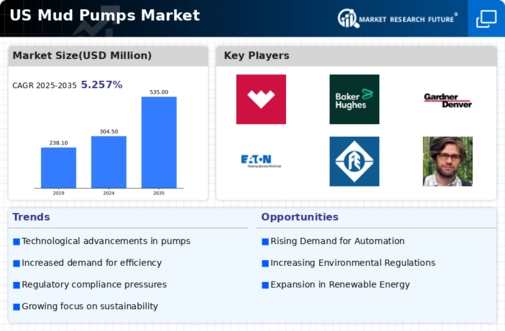Infrastructure Development Projects
Infrastructure development projects across the US are likely to bolster the mud pumps market. With significant investments in construction and civil engineering, the demand for mud pumps is expected to rise. The US government has allocated over $1 trillion for infrastructure improvements, which includes various projects requiring effective mud management solutions. These projects often involve drilling and excavation, where mud pumps play a critical role in maintaining fluid circulation and stability. As these initiatives progress, the mud pumps market is poised to benefit from increased orders and contracts, thereby enhancing market growth and opportunities for manufacturers.
Rising Demand in Oil and Gas Sector
The resurgence of the oil and gas sector in the US is driving the growth of the mud pumps market. As exploration and drilling activities increase, the need for efficient and reliable mud pumps becomes paramount. In 2025, the oil and gas industry is projected to contribute approximately $200 billion to the US economy, indicating a robust demand for equipment such as mud pumps. This sector's expansion necessitates advanced pumping solutions to manage drilling fluids effectively, thereby enhancing operational efficiency. Consequently, manufacturers in the mud pumps market are likely to innovate and improve their product offerings to meet the evolving needs of this dynamic industry.
Environmental Regulations and Compliance
The mud pumps market is also influenced by stringent environmental regulations in the US. As regulatory bodies impose stricter guidelines on drilling operations, companies are compelled to adopt more environmentally friendly practices. This includes the use of mud pumps that minimize waste and reduce the environmental impact of drilling fluids. Compliance with these regulations not only ensures operational legitimacy but also enhances the reputation of companies within the mud pumps market. As a result, manufacturers are likely to focus on developing eco-friendly pump solutions that align with regulatory requirements, potentially leading to increased market share and customer loyalty.
Technological Innovations in Pump Design
Technological innovations in pump design are transforming the mud pumps market. Advances in materials and engineering techniques are leading to the development of more efficient and durable pumps. For instance, the introduction of smart pumps equipped with IoT capabilities allows for real-time monitoring and optimization of performance. This trend is particularly relevant in the US, where the demand for high-performance equipment is on the rise. As companies seek to reduce operational costs and improve productivity, the adoption of these advanced technologies in mud pumps is likely to increase, thereby driving market growth and enhancing competitive dynamics.
Increased Exploration Activities in Unconventional Resources
The exploration of unconventional resources, such as shale gas and tight oil, is significantly impacting the mud pumps market. The US has vast reserves of these resources, and their extraction requires specialized drilling techniques and equipment. As exploration activities intensify, the demand for high-performance mud pumps is expected to rise. In 2025, the unconventional resource sector is projected to account for over 50% of the total oil production in the US, indicating a substantial market opportunity for mud pump manufacturers. This trend suggests that companies must adapt their product offerings to cater to the unique challenges posed by unconventional drilling operations.




















Leave a Comment